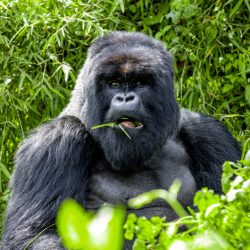Spreading the wealth from mountain gorillas
Blog | 7/10/10
Having mountain gorillas in your backyard can, in many ways, be seen as a curse. They occasionally raid the gardens you depend on and work so hard to cultivate. And each and every day you see foreigners coming and going and spending money that never seems to benefit your family.
Now, though, people who live in close proximity with mountain gorillas are slowly changing the way they view the gorillas and the tourism that they bring. Conversations in communities have, of late, been centered on how Gorilla Levy funds can help directly improve household livelihoods.
In 2008, the Uganda Wildlife Authority (UWA) decreed that 5 USD from mountain gorilla tracking permit sold go back to the communities surrounding Bwindi Impenetrable National Park and Mgahinga Gorilla National Park, the only two protected areas where mountain gorillas live in Uganda.
IGCP worked with UWA, the three local governments of Kisoro, Kabale and Kanungu districts, and other NGOs to develop the process of distributing the funds to the local district authorities. Now, after the first round of Gorilla Levy funds has hit local communities, some problems with the process have been discovered, prompting IGCP to intervene.
In a Perfect World
This specific revenue sharing scheme requires significant participation from the community members and local leaders.
Village Councils, with documented community participation, first generate ideas for Gorilla Levy projects. These projects must fall into priority areas for the funds by either offering direct conservation benefits, addressing issues of marginalized or vulnerable groups, or by directly improving household livelihoods. The proposed projects must include a budget.
These proposals then go through two rounds of review and short-listing, first with the Parish Development Committee and then by the Sub-County Technical Planning Committee. Final approval of proposals is given by the District Council, which are passed on to UWA along with the District Development Plan.
UWA provides oversight to the process and ultimately releases funds to the Districts, which filters down to the communities through the Sub-Counties for implementation and follow-up.
In the Real World
Well, of course nothing goes completely right the first time. Several significant issues were discovered the first time through the Gorilla Levy funding process.
Although local leaders were informed and educated about the Gorilla Levy funds, community members were not. It was assumed that local leaders would be the ones to educate their communities, which in most cases seems not to have happened. Although all parishes submitted proposals for Gorilla Levy funds, they had varied levels of compliance with the guidelines and selection criteria.
The news about the first round of Gorilla Levy is not all bad. Two hundred and eighty nine million Ugandan Shillings (close to 131,000 USD) of Gorilla Levy funds collected between Aug 06 and June 08 have been dispersed around Bwindi and Mgahinga. Communities prioritized projects that distributed pigs , goats and irish potato seeds to community members, supported volunteer groups that work to guard gardens from raids by wildlife, and maintained or improved buffalo-walls or botanical barriers- another way of deterring crop raiding by wildlife.
Stimulating Civic Engagement
IGCP’s current push, through the CARE-EEEGL Project (the full title being Enterprise, Environment, and Equity in the Virunga Landscape of the Great Lakes Region), is to improve understanding of the Gorilla Levy fund process and improve the quality of proposals generated with the ultimate goal of improving livelihoods in areas around the two Gorilla parks in Uganda .
“There was a disconnect between what communities were telling us were the issues and what was being presented as proposals for the Gorilla Levy,” states IGCP Program Officer Stephen Asuma. “What we are hoping for is that these funds can make real contributions to livelihoods and contribute to conservation of protected areas.”
IGCP is encouraging discussion of the Gorilla Levy process and producing sensitization materials (posters, training manual, and video) that will be packaged and distributed in all parishes eligible for Gorilla Levy funds.
Maintaining the Link to Gorilla Conservation
There has been a history of human-wildlife conflict around protected areas in Uganda, which continues today. Gorilla Levy funds are an opportunity to build good will with communities and a way to fund projects that reduce the conflict between people and conservation.
The name Gorilla Levy itself means that all the community members know that this money comes directly from gorilla tourism. The money isn’t lumped in with other funds from government; the community directly gets to discuss and choose how they feel they can best overcome the “negative” aspects of living in close proximity to mountain gorillas.
In addition, there are conditions on the funds that mean that no projects that are in direct conflict with conservation efforts can be funded. And projects which directly contribute to conservation receive priority. IGCP, as a member of the Gorilla Levy Technical Committee, is making an effort to help communities identify projects that better enable the communities to contribute to conservation.
Gorilla Levy funds become a way that communities can see the direct and positive affect mountain gorilla tourism has on their community. But the process and the projects have to be successful and positive for this to work. Members of the Gorilla Levy Technical Committee comprised of IGCP, UWA, local governments, and NGOs are continuing to work together, by putting the effort into making Gorilla Levy funds a success for all involved- communities and mountain gorillas.
Work on Gorilla Levy is part of a larger CARE-IGCP joint project Enterprise, Environment and Equity in the Virunga Landscape of the Great Lakes Region or (EEEGL). For more information on the EEEGL project, please visit http://www.virunga.net.
Photo caption: Members of the Rubuguli community pretest informational posters about how communities can obtain Gorilla Levy funds in a meeting held Sepbember 23, 2010. Rubuguli was one of five areas where communities gave input on the materials.


